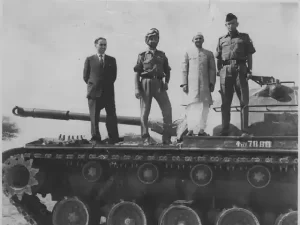
Pic courtesy: Hindustan times
The Indo-Pakistani war of 1965 (also called the Second Kashmir War) was the second major war fought between the two countries after the partition in 1947.
The genesis of the Indo-Pak wars lies in factors like the British colonial misrule, religious differences, and cold war geopolitics. The fate of India, and that of Kashmir, had been sealed in 1919, when Britain’s India Office, prepared a plan to partition the Indian subcontinent based on religion. After independence and partition, the region became part of the larger cold war struggle between the United States and the Soviet Union.
The 1965 war was a culmination of skirmishes that took place in the preceding months. The seventeen-day war (06 Sep – 22 Sep 65) caused thousands of casualties on both sides. India had the upper hand over Pakistan when the ceasefire was declared and the conflict was seen as a strategic and political defeat for Pakistan.
Prevailing Circumstances.
- In 1965 India was still recovering from the 1962 war with China. Belligerent Pakistan thought it to be the right time to wrest Kashmir from India.
- In March 1963, Pakistan, under General Ayub Khan, had ceded the Shaksgam Valley in Pakistan-occupied Kashmir (PoK) to China.
- Pakistan military, Post-Southeast Asia Treaty Organisation (SEATO), and Central Treaty Organisation (CENTO) Agreements had received new weapons and equipment from the US, acquiring an edge over India in air power, armour, and artillery.
- In addition, its economy was doing extremely well.
- On the other hand, India was recovering from the 1962 Indo-China war.
- The prevailing civil-military relations were not in a healthy state, with the situation becoming worse with apathy toward essential requirements of the armed forces.
- Pakistan’s political scene was upbeat, and its military felt a sense of superiority over India. Against this backdrop, ambitious and reckless plans were made by Pakistan, trying to replicate what the People’s Liberation Army (PLA) had done in 1962.
- Pakistan did not take into account the rapid changes that had taken place in the Indian military, post-1962.
Testing Waters. The skirmishes started in April 1965, with a Pakistani attack on Indian forces in the Rann of Kutch. India responded and repulsed the attack and also mobilised its troops in the Punjab and Kargil sectors, but stood down the troops by the end of July, in response to the UN intervention. Pakistan did not back off.
Operation Gibraltar. Pakistan launched Operation Gibraltar in August, by sending covertly about 12,000 trained mujahids to Kashmir. Pakistan expected India to collapse, however, India repulsed the attack and even cut off the entry and exit points into the Kashmir Valley by capturing the Haji Pir Bulge. Operation Gibraltar fizzled out.
Operation Grand Slam. Pakistan then launched Operation Grand Slam in September 1965 in Chhamb and Jaurian sectors. The Indian counter-attack resulted in engagement spreading to various sectors along the border, turning the armed skirmishes into full-scale war.
Ceasefire and agreement. The war continued till the United Nations negotiated a ceasefire on 22 September. The formal peace agreement was signed at Tashkent four months later on 10 January 1966. Prime Minister Lal Bahadur Shastri and President Ayub Khan, agreed to observe the ceasefire lines and withdraw their respective armed personnel to positions that they had held before 5 August 1965. Both sides claimed victory in this war.
Casualties. Official Indian figures put the total number of casualties at 12,714, out of which 2,763 were killed, 8,444 wounded, and 1,507 went missing. Pakistani deaths were over 5,000 according to neutral observers. Even after the cease-fire, it is estimated that about 2,000 causalities occurred due to local border skirmishes.
Victory. The success or failure of war depends upon the success or failure to achieve the political aim/objective. Pakistan failed to achieve its primary objective of annexing Kashmir. In the military domain, Pakistan suffered heavily in men and materials, in spite of her superiority in arms and equipment. Considering Pakistan Army’s numerical advantage in armour, artillery and other weapons, the inference drawn was that India won the war. A number of journalists and researchers have stated that India won the war, but there are some who feel that the war was militarily inconclusive or ended in a draw.
Leadership Aspects
- Prime Minister Lal Bahadur Shastri displayed an Iron will and gave a free hand to the military.
- Defence Minister Shri YB Chavan, has been criticised by analysts for misplaced priorities and poor decision-making.
- Army Chief Gen JN Chaudhuri failed to integrate the Indian Air Force and Navy into his war plans.
- The leadership and performance of the junior officers and troops was exemplary. They acquitted themselves admirably despite the obsolete equipment and lack of intelligence.
- Pak performance. The performance of Pakistani political and military leadership was also not very inspiring. In spite of the advantage of better equipment and initiative in operations, they could not achieve their objectives. Poor military leadership at the higher level by General Ayub Khan stands out as the principal reason of the failure of the Pakistan Army to inflict a decisive military defeat on India.
Bottom Line
Technology is important for War.
But more important are LEADERSHIP, MORALE, TRAINING and TACTICS.
Question
Will Aniveers under Agnipath be able to deliver?
Suggestions and value additions are most welcome
For regular updates, please register here
References and credits
To all the online sites and channels.
Disclaimer:
Information and data included in the blog are for educational & non-commercial purposes only and have been carefully adapted, excerpted, or edited from sources deemed reliable and accurate. All copyrighted material belongs to respective owners and is provided only for purposes of wider dissemination.

I strongly feel that the IAF lost the 1965 war.